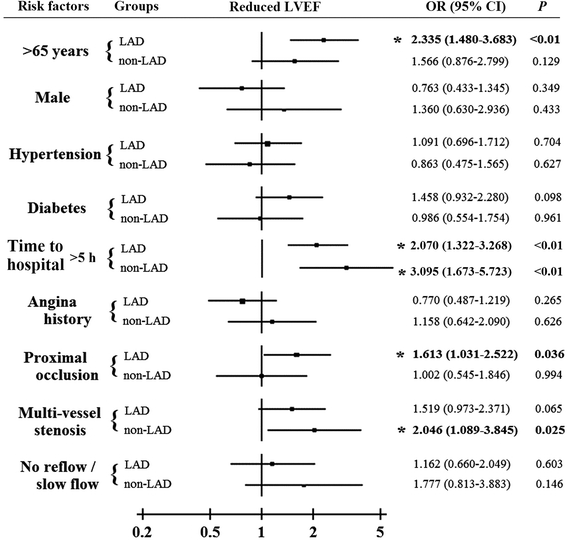Rapid predictors for the occurrence of reduced left ventricular ejection fraction between LAD and non-LAD related ST-elevation myocardial infarction
- PMID: 26728478
- PMCID: PMC4700617
- DOI: 10.1186/s12872-015-0178-y
Rapid predictors for the occurrence of reduced left ventricular ejection fraction between LAD and non-LAD related ST-elevation myocardial infarction
Abstract
Backgrounds: Reduced left ventricular ejection fraction (LVEF) after acute myocardial infarction (AMI), which implies the occurrence of cardiac dysfunction, impacts cardiac prognosis, even after primary percutaneous coronary intervention (PCI). This study was designed to clarify the difference of clinical and angiographic predictors for reduced LVEF in ST-elevation myocardial infarction (STEMI) patients with left anterior descending artery (LAD) or non-LAD vessel as culprit artery.
Methods: This was a retrospective study to review a total of 553 patients of STEMI underwent primary PCI in our hospital. All patients underwent echocardiography. Univariate analysis, multivariate analysis and classification and regression tree (CART) were performed between LAD related AMI and non-LAD related STEMI. The primary outcome was the occurrence of reduced LVEF 4-6 days after PCI.
Results: In this study, culprit arteries of STEMI were 315 in LAD system (6 in left main artery, 309 in LAD) and 238 in non-LAD system (63 in left circumflex and 175 in right coronary artery). Compared with non-LAD group, post-MI LVEF was significantly reduced in LAD related STEMI group (52.4 ± 9.3% vs. 57.1 ± 7.8%, P < 0.01). Multivariate analysis indicated that elder (>65 years), time to hospital and proximal occlusion were associated with reduced LVEF (<55%) in LAD related STEMI patients. However, in non-LAD patients, time to hospital, multivessel stenosis and post-PCI blood pressure predicted the occurrence of reduced LVEF. Furthermore, CART analysis also obtained similar findings.
Conclusions: Patients with LAD or non-LAD related STEMI could suffer reduced LVEF, while the clinical and angiographic predictors for the occurrence were different.
Figures



Similar articles
-
Long-Term Outcomes in Survivors of Early Ventricular Arrhythmias After Acute ST-Elevation and Non-ST-Elevation Myocardial Infarction Treated With Percutaneous Coronary Intervention.Am J Cardiol. 2016 Mar 1;117(5):709-13. doi: 10.1016/j.amjcard.2015.12.002. Epub 2015 Dec 13. Am J Cardiol. 2016. PMID: 26796195
-
Effect of coronary occlusion site on angiographic and clinical outcome in acute myocardial infarction patients treated with early coronary intervention.Am J Cardiol. 2006 Apr 15;97(8):1137-41. doi: 10.1016/j.amjcard.2005.11.027. Epub 2006 Feb 28. Am J Cardiol. 2006. PMID: 16616014
-
Left anterior descending coronary artery flow after primary angioplasty in acute anterior ST-elevation myocardial infarction: how much flow is needed for left ventricular functional recovery?Eur Heart J Acute Cardiovasc Care. 2014 Sep;3(3):223-8. doi: 10.1177/2048872614521763. Epub 2014 Feb 3. Eur Heart J Acute Cardiovasc Care. 2014. PMID: 24493865
-
Diagnosis and prognosis of myocardial infarction in a patient without obstructive coronary artery disease during bronchoscopy: a case study and literature review.BMC Cardiovasc Disord. 2020 Apr 21;20(1):185. doi: 10.1186/s12872-020-01458-5. BMC Cardiovasc Disord. 2020. PMID: 32316919 Free PMC article. Review.
-
First-degree relatives with similar phenotypic characterisation of acute myocardial infarction: a case report and review of the literature.BMC Cardiovasc Disord. 2019 Dec 27;19(1):314. doi: 10.1186/s12872-019-01303-4. BMC Cardiovasc Disord. 2019. PMID: 31881949 Free PMC article. Review.
Cited by
-
Comparison of angiographic results and clinical outcomes of no-reflow after stenting in left anterior descending (LAD) versus non-LAD culprit STEMI.SAGE Open Med. 2022 Mar 31;10:20503121221088106. doi: 10.1177/20503121221088106. eCollection 2022. SAGE Open Med. 2022. PMID: 35387152 Free PMC article.
-
Using latent class analysis to identify clinical features of patients with occlusive myocardial infarction: Preangiogram prediction remains difficult.Clin Cardiol. 2022 Feb;45(2):231-238. doi: 10.1002/clc.23755. Epub 2022 Feb 8. Clin Cardiol. 2022. PMID: 35132645 Free PMC article.
-
The Current Status of Intervention for Intermediate Coronary Stenosis in the Korean Percutaneous Coronary Intervention (K-PCI) Registry.Korean Circ J. 2019 Nov;49(11):1022-1032. doi: 10.4070/kcj.2019.0074. Epub 2019 Jun 5. Korean Circ J. 2019. PMID: 31190480 Free PMC article.
-
The diagonal branches and outcomes in patients with anterior ST- elevation myocardial infarction.BMC Cardiovasc Disord. 2020 Mar 4;20(1):108. doi: 10.1186/s12872-020-01386-4. BMC Cardiovasc Disord. 2020. PMID: 32131738 Free PMC article.
-
Early prediction of ventricular functional recovery after myocardial infarction by longitudinal strain study.Am J Cardiovasc Dis. 2021 Aug 15;11(4):471-477. eCollection 2021. Am J Cardiovasc Dis. 2021. PMID: 34548945 Free PMC article.
References
-
- Hung J, Teng TH, Finn J, Knuiman M, Briffa T, Stewart S, et al. Trends from 1996 to 2007 in incidence and mortality outcomes of heart failure after acute myocardial infarction: a population-based study of 20,812 patients with first acute myocardial infarction in Western Australia. J Am Heart Assoc. 2013 Oct 8;2(5):e000172. - PMC - PubMed
-
- Thomas KL, Velazquez EJ. Therapies to prevent heart failure post-myocardial infarction. Curr Heart Fail Rep. 2005;2(4):174–82. - PubMed
-
- Zaret BL, Wackers FJ, Terrin ML, Forman SA, Williams DO, Knatterud GL, et al. Value of radionuclide rest and exercise left ventricular ejection fraction in assessing survival of patients after thrombolytic therapy for acute myocardial infarction: results of Thrombolysis in Myocardial Infarction (TIMI) phase II study. The TIMI Study Group. J Am Coll Cardiol. 1995;26:73–9. - PubMed
MeSH terms
LinkOut - more resources
Full Text Sources
Other Literature Sources
Medical
Miscellaneous

